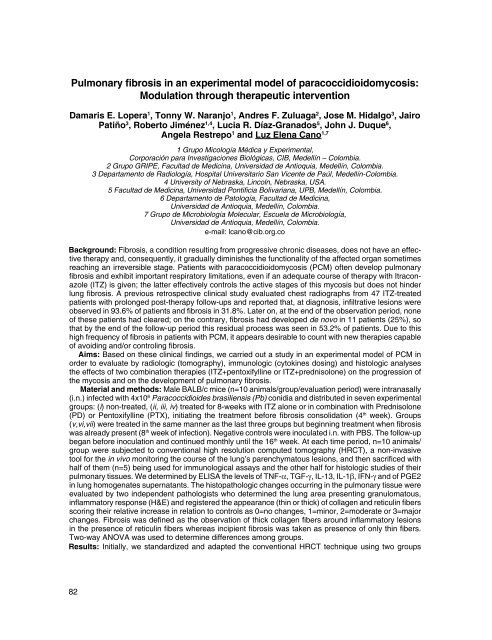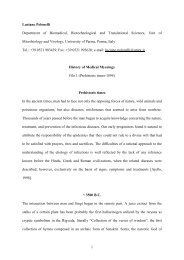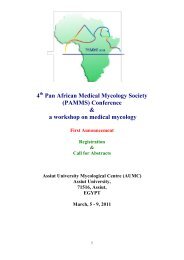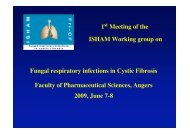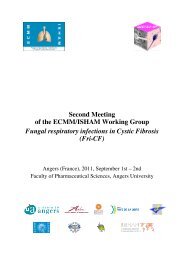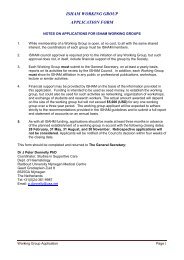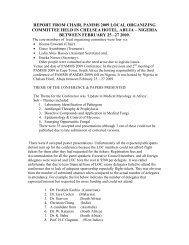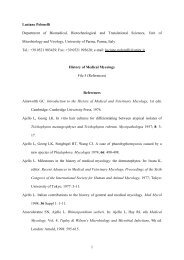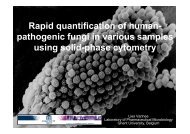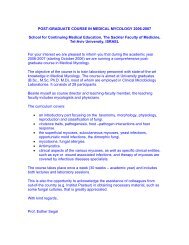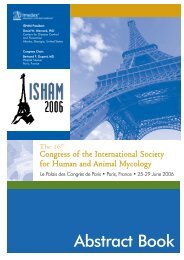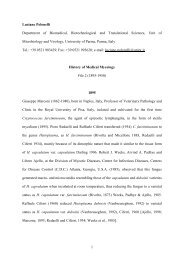Pulmonary fibrosis in an experimental model of paracoccidioidomycosis:Modulation through therapeutic interventionDamaris E. Lopera 1 , Tonny W. Naranjo 1 , Andres F. Zuluaga 2 , Jose M. Hidalgo 3 , JairoPatiño 3 , Roberto Jiménez 1,4 , Lucia R. Díaz-Granados 5 , John J. Duque 6 ,Angela Restrepo 1 and Luz Elena Cano 1,71 Grupo Micología Médica y Experimental,Corporación para Investigaciones Biológicas, CIB, Medellín – Colombia.2 Grupo GRIPE, Facultad de Medicina, Universidad de Antioquia, Medellín, Colombia.3 Departamento de Radiología, Hospital Universitario San Vicente de Paúl, Medellín-Colombia.4 University of Nebraska, Lincoln, Nebraska, USA.5 Facultad de Medicina, Universidad Pontificia Bolivariana, UPB, Medellín, Colombia.6 Departamento de Patología, Facultad de Medicina,Universidad de Antioquia, Medellín, Colombia.7 Grupo de Microbiología Molecular, Escuela de Microbiología,Universidad de Antioquia, Medellín, Colombia.e-mail: lcano@cib.org.coBackground: Fibrosis, a condition resulting from progressive chronic diseases, does not have an effectivetherapy and, consequently, it gradually diminishes the functionality of the affected organ sometimesreaching an irreversible stage. Patients with paracoccidioidomycosis (PCM) often develop pulmonaryfibrosis and exhibit important respiratory limitations, even if an adequate course of therapy with Itraconazole(ITZ) is given; the latter effectively controls the active stages of this mycosis but does not hinderlung fibrosis. A previous retrospective clinical study evaluated chest radiographs from 47 ITZ-treatedpatients with prolonged post-therapy follow-ups and reported that, at diagnosis, infiltrative lesions wereobserved in 93.6% of patients and fibrosis in 31.8%. Later on, at the end of the observation period, noneof these patients had cleared; on the contrary, fibrosis had developed de novo in 11 patients (25%), sothat by the end of the follow-up period this residual process was seen in 53.2% of patients. Due to thishigh frequency of fibrosis in patients with PCM, it appears desirable to count with new therapies capableof avoiding and/or controling fibrosis.Aims: Based on these clinical findings, we carried out a study in an experimental model of PCM inorder to evaluate by radiologic (tomography), immunologic (cytokines dosing) and histologic analysesthe effects of two combination therapies (ITZ+pentoxifylline or ITZ+prednisolone) on the progression ofthe mycosis and on the development of pulmonary fibrosis.Material and methods: Male BALB/c mice (n=10 animals/group/evaluation period) were intranasally(i.n.) infected with 4x10 6 Paracoccidioides brasiliensis (Pb) conidia and distributed in seven experimentalgroups: (i) non-treated, (ii, iii, iv) treated for 8-weeks with ITZ alone or in combination with Prednisolone(PD) or Pentoxifylline (PTX), initiating the treatment before fibrosis consolidation (4 th week). Groups(v,vi,vii) were treated in the same manner as the last three groups but beginning treatment when fibrosiswas already present (8 th week of infection). Negative controls were inoculated i.n. with PBS. The follow-upbegan before inoculation and continued monthly until the 16 th week. At each time period, n=10 animals/group were subjected to conventional high resolution computed tomography (HRCT), a non-invasivetool for the in vivo monitoring the course of the lung’s parenchymatous lesions, and then sacrificed withhalf of them (n=5) being used for immunological assays and the other half for histologic studies of theirpulmonary tissues. We determined by ELISA the levels of TNF-α, TGF-γ, IL-13, IL-1β, IFN-γ and of PGE2in lung homogenates supernatants. The histopathologic changes occurring in the pulmonary tissue wereevaluated by two independent pathologists who determined the lung area presenting granulomatous,inflammatory response (H&E) and registered the appearance (thin or thick) of collagen and reticulin fibersscoring their relative increase in relation to controls as 0=no changes, 1=minor, 2=moderate or 3=majorchanges. Fibrosis was defined as the observation of thick collagen fibers around inflammatory lesionsin the presence of reticulin fibers whereas incipient fibrosis was taken as presence of only thin fibers.Two-way ANOVA was used to determine differences among groups.Results: Initially, we standardized and adapted the conventional HRCT technique using two groups82
of mice (PBS-untreated as negative controls and Pb-infected untreated as positive controls). For thispurpose we used a multi-slice CT-scanner Lightspeed (General Electric, EU of 16 channels) for humanpatients, to characterize and monitor the course of the lung’s parenchymatous lesions, pulmonary density(pδ, expressed as Hounsfield units, HU) and volume alterations. We observed that the major changesoccurred in the upper lung fields where the Pb-infection induced peri-bronchial and parenchymatousconsolidations that increased significantly (p≤0.001) the pδ in those zones (-263.2±29.6, -191.2±25.1,-269.5±43.5 and -356.5±33.6 HU for 4, 8, 12 and 16 weeks post-infection, respectively) with respectto pδ of negative controls that remained constant around -432.7±24.2HU. Additionally, multiple peripheralnodules were noticed in 60% of the mice at the end of the follow-up. In sharp contrast, the groupstreated with ITZ alone or in combination with PD or PTX normalized the pδ with values similar those ofthe negative controls.Histopathologic analyses showed that Pb-infection induced a significant (p≤0.001) increase of theperi-bronchial granulomatous inflammatory response that involved 10%-35% of the lung’s area, withvalues of 10±7, 22±15, 20±11 and 15±10% at 4, 8, 12 and 16 weeks, respectively. In contrast, after onemonth post therapy, groups (ii) (iii) and (iv) showed a significant decrease (p≤0.01) of the areas exhibitinginflammatory response (9.3±3%, 4±1.5% and 1.8±0.6% for ITZ, ITZ+PD and ITZ+PTX, respectivelyat 8 th week) and also at the end of the follow-up (3.5±1, 2.5±1.2 and 1.3±0.6%). When therapy had beenstarted 8-weeks post-challenge, ITZ alone also reduced significantly (p≤0.05) the inflammatory area afterfour-week of treatment (11±3% Vs 20±11); however, such a reduction was more significant (p≤0.001)with both combination therapies (6.7±3%).Eighty percent of the Pb-infected mice showed incipient pulmonary fibrosis after 4 weeks post-infection;later on (8–12 weeks), this process progressed to well-established fibrosis in 60% of the mice andreached 100% at 16-weeks. In group (ii) at 4-weeks post-treatment, a significant reduction (p≤0.05) inthe score assigned to thin reticulin and collagen fibers deposition was observed along with a score=0for thick fibers (p≤ 0,05). Consequently, at 16-weeks, 80% of these mice had incipient fibrosis, none(0%) had well-established sequelae while 20% had no sings of fibrosis. Notably, ITZ+PD and ITZ+PTXwhen initiated at the 4 th week, were more efficient in diminishing fibrosis than ITZ alone; at the end of thefollow-up period these therapies avoided either form of fibrosis in 60% and 80% of mice, respectively,in contrast with 20% when ITZ was given alone. The remainder mice presented incipient fibrosis. Group(v), presented a significant reduction (p≤0,05) in the score assigned to thin reticulin and collagen fibersdeposition. This effect was observed after 2 months, whereas combination treatment in groups (vi) and(vii) induced the same effect from the first month of treatment. Additionally, ITZ-therapy started at 8weeks, was unable to completely prevent the progress to severe fibrosis and at the end of the followup,40% had incipient fibrosis, 20% had severe fibrosis and 40% of the mice had no apparent fibrosis.Instead, combination treatments, prevented the appearance of severe fibrosis in groups (vi) and (vii). Theimmunological assays showed that Pb-infection induced in the lungs a significantly (p=0.01) increasein pro-inflammatory cytokines (TNF-α, IL-1β) and in PGE2, although each molecule presented differentkinetics. TNF-α levels were higher during all observation periods (p=0.001), IL-1β levels increased untilthe 8-week and then decreased to reach normal levels while and PGE2 increased only at 8 th -week postinfection.Pro-fibrotic cytokines (IL-13, TGF-β also increased but only at 8-weeks post infection. IFN-γlevels did not experience significant changes during the studied periods. All therapies normalized levelsof all cytokines studied and, also of PGE2, except for TGF-β. This molecule, in contrast, increased significantly(p=0.05), especially in groups that received combination treatment.Conclusions: These preliminary results suggest that in Pb-infected mice: 1) the progression to severepulmonary fibrosis can be avoided by early ITZ treatment; 2) ITZ+PD and ITZ+PTX started after 4 weeksof infection, avoided either form of fibrosis in 60% and 80% of mice, respectively and in contrast with20% when ITZ was given alone, and 3) Even when the combination therapies were started during thechronic periods of infection (8 weeks), they also avoided the development of severe pulmonary fibrosis.These experimental results open an important and interesting possibility for avoiding severe fibrosis inthe human patients by the early administration of the combination therapies proposed.Financial support: Colciencias (Project No. 2213-04-16439), Corporación para Investigaciones Biológicas(CIB), University of Antioquia, Radiology Department of Hospital Universitario San Vicente de Paúl.83


